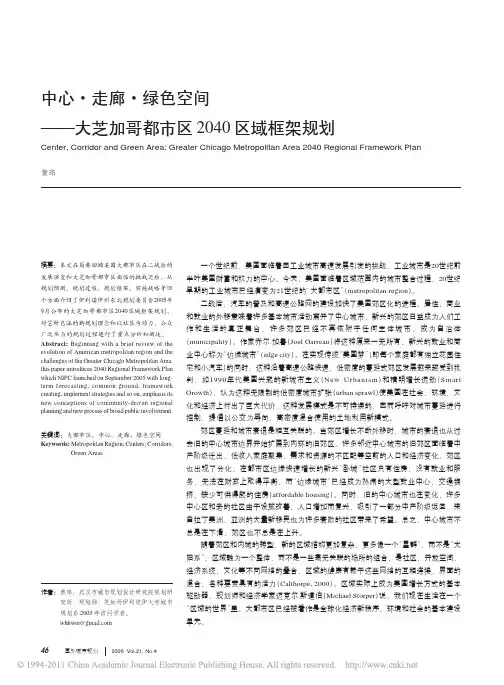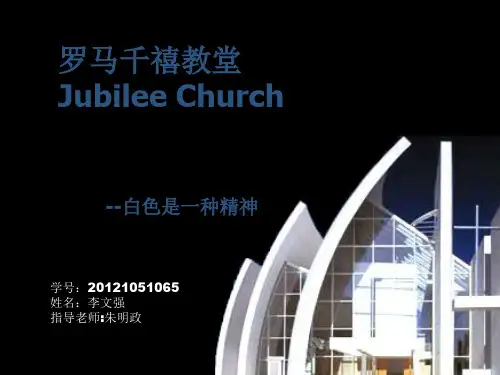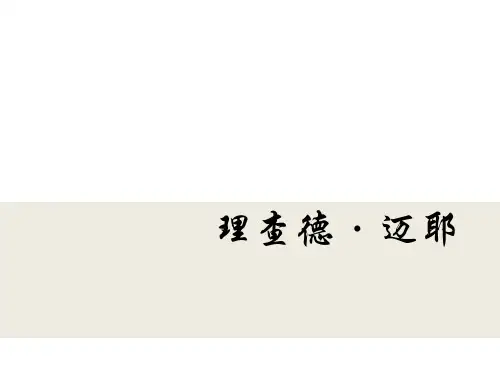理查德迈耶-美国芝加哥河发展规划
- 格式:pdf
- 大小:12.18 MB
- 文档页数:88





理查德·迈耶 〔Richard Meier,1934-〕 美国建筑师,现代建筑中白色派的重要代表。曾就学于纽约州伊萨卡城康奈尔大学,早年曾在纽约的S.O.M建筑事务所和布劳耶事务所任职,并兼任过许多大学的教职;1963年自行开业。
迈耶的作品以“顺应自然”的理论为基础,他表面材料常用白色,以绿色的自然景物衬托,使人觉得清新、脱俗。他善于利用白色表达建筑本身与周围环境的和谐关系。在建筑内部运用垂直空间和天然光线在建筑上的反射达到富于光影的效果。他以新的观点解释旧的建筑语汇,并重新组合于几何空间。他特别主张回复到20年代荷兰风格派和勒·柯布西耶倡导的立体主义构图和光影变化,强调面的穿插,讲究纯净的建筑空间和体量。
迈耶的代表作品有法兰克福装饰艺术博物院、海牙市政厅及中心图书馆密执安州道格斯拉住宅(1974)、纽约州布朗克斯发展中心(1976)、新哈莫尼文艺俱乐部(1978)和亚特兰大高级美术馆(1983)等。 [主要作品]
项目名称:罗马千禧教堂Jubilee Church 项目地址:罗马,意大利Rome, Italy 建筑设计:理查德·迈耶 Richard Meier & Partners 建成时间:2003
与周围环境有机结合,特别是三片弧墙的闪亮一笔,使建筑脱胎换骨,室内光线经过弧墙的反射,一定显得静谧和洒脱。
“白”是迈耶建筑不可缺少的元素,而白的墙就像画纸,光影就在其上自由的作着移动的图画。
“白”是迈耶的作品给我们的第一印象。尽管白色派的建筑未必白,就迈耶而言,这个称号却是名副其实的,在以色彩浓艳的墙,红黄蓝绿的管线,眼花缭乱的装饰为标志的种种时髦设计面前,他的白色建筑自有一种超凡脱俗的气派。与二战后开始流行的暴露材料本色的设计相反,他做的白色光洁表面具有明显的非天然效果。这就是迈耶建筑的特点,也是他建筑的魅力所在——纯净。然而,纯净不等于单调,精练的设计可以同时是一个富于艺术表现力的设计,如果说密斯(Mise Van der Rohe)后期那些钢加玻璃的大空间给人于冷峻之感,那么迈耶的作品却有另一番情调。虽然他的局部素材来自于现代建筑,整体却没有枯燥的气氛,原因在于内外某些部分的体量被巧妙地增减,赋予建筑明显的雕塑风味。






“白”色建筑师——理查德·迈耶请理查德·迈耶Richard Meier理查德·迈耶,美国建筑师,现代建筑中白色派的重要代表。
曾就学于纽约州伊萨卡城康奈尔大学。
早年曾在纽约的S.O.M建筑事务所和布劳耶事务所任职,并兼任过许多大学的教职。
1963年,迈耶在纽约组建了自己的工作室,其独创能力逐渐展现在家具、玻璃器皿、时钟、瓷器、框架以及烛台等方面。
•平生在事务所成立初期,理查德·迈耶所接的是一些如室内修复的小案子。
之后,他的父母要求他替他们设计一幢住宅,为此理查迈耶特地跑到赖特所设计的流水别墅去体会那种水平的空间感,并试图将赖特那室内的空间延伸到外部环境的手法,运用到自己设上由于兴趣使然,理查德·迈耶对于“剪贴画”也是相当有研究,迈耶本身也认为从“剪贴画”中他学到了但由于两者基地环境的条件并不是全然相同,而使理查德·迈耶饱受挫折,在失望之余,他便转而研究其他大师的作品,而勒·柯布西耶的许多观念却恰巧与他的想法相吻合,于是便种下了理查德·迈耶早期的作品走勒·柯布西耶的路线。
由于兴趣使然,理查德·迈耶对于“剪贴画”也是相当有研究,迈耶本身也认为从“剪贴画”中他学到了许多启示,而事实证明在他的设计中,也不时可看出他运用了许多如“把物象经解析再重组”的剪贴画手法。
迈耶本人亦承认,在造型上他并没有作什么创新,他只不过将前人所曾使用的语汇加以重组,而产生某种新的意义罢了;例如史密斯住宅,只不过是勒·柯布西耶的多米诺与西楚汉两种原型的重组罢了。
理念迈耶设计的产品都颇为简练,既包括居家设计也包括商用设计。
他设计的作品最大的特点是永远有自己的特性而不是在风格上受别人的影响而迷惑。
由于其大胆的风格和值得称颂的忠诚,迈耶创造出颇为独特的粗壮风格。
为了在展示方面做得更好,他将斜格、正面以及明暗差别强烈的外形等方面和谐地融合在一起。
理查德迈耶设计理念理查德·迈耶(Richard Meier)是美国著名的建筑师和设计师,他以他的现代主义建筑风格而闻名。
迈耶的设计理念植根于现代主义建筑的核心原则,强调清晰的几何形式、功能性和材料的纯净性。
首先,迈耶注重建筑的几何形式。
他善于运用简单、明晰的几何图形来创造富有节奏感的建筑形式。
他的建筑作品中常常出现的横向和纵向的线条,直角和圆角以及几何图形的组合,营造出了一种简洁而富有力量感的视觉效果。
例如,他设计的洛杉矶大剧院(Los Angeles County Museum of Art)就采用了一系列的长方形平面和交错的几何形式,使建筑成为一个无可辩驳的视觉艺术品。
其次,迈耶注重建筑的功能性。
他认为建筑是为人们服务的,因此设计应当围绕着人的需求和活动而展开。
他的建筑作品常常呈现出流畅而连续的空间布局,强调人们在其中的自由活动和沟通。
同时,他注重利用充足的自然采光和通风,为使用者创造舒适的环境。
例如,在迈耶设计的贝茨学校艺术学楼(Bates College Art Building)中,大量的白色墙壁和巨大的窗户使得室内光线明亮,空间通透,使学生们可以更好地进行创作和交流。
最后,迈耶注重材料的纯净性。
他相信建筑材料的自然本质和纯净美可以成为建筑的核心元素。
他的建筑作品经常使用白色的立面和大量的玻璃材料,以突出建筑结构和形式的纯粹性。
他还善于运用透明和半透明的材料,使得室内和室外的空间相互交融,创造出一种充满温暖和开放感的氛围。
例如,在迈耶设计的洛杉矶天使广场图书馆(Los Angeles Central Library)中,白色的大理石墙面和透明的玻璃幕墙大大增强了建筑的现代感和质感。
总的来说,理查德·迈耶的设计理念体现了现代主义建筑的核心原则,包括几何形式的清晰性、功能性和材料的纯净性。
他的建筑作品以简洁明快、纯粹而有力的设计语言赢得了广泛的赞誉,成为现代建筑界的重要代表之一。
City of ChicagoRichard M. Daley, MayorDepartment of Planning and DevelopmentChristopher R. Hill, Commissioner1999C H I C A G O R I V E R C O R R ID O RD E V E L O P M E N T PL A NF OREWORD1C HAPTER O NE : I NTRODUCTIONWhy a development plan for the Chicago River?2Chicago River Development Goals 4Planning Process 6C HAPTER T WO : T HE P LANReaches and Opportunity Sites:81. North Shore Channel 10• Devon to Lawrence 12• Bryn Mawr to Foster142. Upper North Branch: City Limits to Cicero 163. Upper North Branch: Cicero to Lawrence 18• Foster to Lawrence204. Middle North Branch: Lawrence to Diversey 22• Neighborhood Overlook Prototype - 124• Neighborhood Overlook Prototype - 226• Neighborhood River Edge Improvements Prototype 28• Horner Park30• Irving Park to Addison 32• Addison to Belmont34• Industrial Area Overlook 36• Lathrop Riverwalk385. Lower North Branch: Diversey to Chicago 40• Damen to Fullerton 42• Fullerton Plaza44• Union Pacific Railroad Bridge to Webster 46• North Avenue Turning Basin486. Downtown Main Branch: Chicago to Congress 50• Erie Street Terraces52• North Branch Boardwalk 54• Riverwalk Gateway56• Rush Street Park Improvements 58• 300 South Wacker 60• Wolf Point627. South Branch Riverwalk: Congress to Halsted 648. South Branch: Halsted to Kedzie 66• South Branch Turning Basin 68• Canalport Riverwalk709. Sanitary & Ship Canal: California to City Limits 72C HAPTER T HREE : I MPLEMENTATION S TRATEGIESOverview & Setback ordinance 74Design Guidelines76Capital Improvement Program 78Environmental Recommendations79Public/Private River Development Corp.82A CKNOWLEDGEMENTS 83 B IBLIOGRAPHY86C o n t e n ts1F o r e w o r dIn 1997, the Department of Planning and Development of the City of Chicago assembled a team representing the government, private sector developers, and non-profit organizations to create a blueprint for the future of the Chicago River. Their goal was to enhance the river’s attractiveness as a natural and recreational resource, while respecting the needs of residential and business developments.The Chicago River Corridor Development Plan and Design Guidelines are results of this collaborative effort. This ten-year action plan sets forth a shared vision for the river and outlines specific recommendations for achieving that vision.Components of the plan include:D EVELOPMENT O PPORTUNITIES Specific recommendations for improvements to public and private land that support the goals of the plan.S ETBACK O RDINANCELocal legislation that provides for increased landscaped open space along the river.E NVIRONMENTAL A CTION A GENDAStrategies for preserving and enhancing the river’s natural areas.D ESIGN G UIDELINESC APITAL I MPROVEMENT P ROGRAMThe authors of this document hope that all who know and love the Chicago River will join in the thoughtful and sustainable development of this precious resource.The Chicago River through downtown Chicago2Chicago River Corridor Development PlanWhy a Development Plan for the Chicago River?Chapter One: Intro d u c t i o nThe Chicago River is one of the city’s mosttreasured and accessible natural resources, flowing through residential neighborhoods and industrial areas alike. Formerly those same industrial areas were sources of severe contamination of the river and its banks. But over the last 25 years, local and federal government agencies have invested more than $4 billion in pollution control and other water quality improvements. Both humanresidents and wildlife are returning to the river.More and more Chicagoans look to it as an attractive place to work, live, and play.This renewed interest in the river is resulting in new kinds of development. Residential andcommercial uses are replacing the more traditional industrial plants which once relied on the river for transportation of raw materials. Many of the remaining industrial uses are developing their waterfronts as amenities for their employees, with seating areas and green space. The City of Chicago created the Chicago River Corridor Development Plan and Design Guidelines as a vision and set of standards for new development that will increase public access and create new recreational opportunities for all the city’s residents.H ISTORYChicago’s phenomenal growth into a major urban center is due, in large part, to its strategic location on the Chicago River and Lake Michigan. As early as the 1600’s the river and the lake were major trade routes.By the City’s incorporation in 1836, the river had already been established as a desirable location for industrial development. The first meat packing plant adjacent to the river opened in 1829 and the first lumber mill in 1833. These two industries were located just north of Wolf Point at theconfluence of the north and south branches of the Chicago River.The completion of the Illinois and Michigan Canal in 1848 linked Lake Michigan with theMississippi River, dramatically increasing river traffic. By the 1860’s, the river had become the focus of industrial development with an emphasis on meat packing and lumber.In the city’s early history the river was also used as a sewage outlet. Waste flowed east to Lake Michigan, the city’s drinking water source,resulting in frequent outbreaks of water-borne diseases. In 1890, the Sanitary and Ship Canal was built both to protect the water supply and to provide greater shipping capacity. Theconstruction of the Canal reversed the flow of the river, sending pollution away from Lake Michigan and into the Mississippi River system. The Sanitary and Ship Canal also became the main materials transportation artery, replacing the obsolete Illinois and Michigan Canal which was eventually filled in.Chicago’s industrial legacy will likely remain a strong feature of development along the Chicago River, particularly along the South Branch and the Sanitary and Ship Canal. However, public demand for access and recreational amenities continues to grow, ensuring that future development will include a diverse mix of industrial, commercial,residential, and recreational uses.Fullerton Plaza overlook by the Chicago RiverChicago Riverwalk in Downtown ChicagoChapter One: Introduction3Southeastward view of the Chicago River over Wolf Point around 1900Burnham’s vision for the Chicago RiverChicago River Corridor Development Plan4Chicago River Development Goals1. PATHS AND GREENWAYSCreate a connected greenway along the river ,with continuous multi-use paths along at least one side of the river .• This can be accomplished through improvements to existing public paths and the creation of new path segments through private property.• Beyond the city limits, the river path can be linked to existing and proposed paths such as the Lincolnwood Trail and the Illinois and Michigan Canal Corridor.2. PUBLIC ACCESSIncrease public access to the river through the creation of overlooks and public parks. • Where feasible, private developments along the river should include opportunities for public access, such as pocket parks with seating areas.• Streets that dead-end at the river can be developed as overlooks for the adjacent community.Five key components frame the Chicago River Corridor Development Plan and Design Guidelines:Chapter One: Introduction53. HABITAT AND LANDSCAPINGRestore and protect landscaping and natural habitats along the river, particularly fish habitat.•Given the river’s industrial history, little of its pre-settlement “natural” character remains. As redevelopment proceeds, care should be taken to create landscaped buffers and wetlands, both to soften harsh urban edges and to support wildlife.4. RECREATIONDevelop the river as a recreational amenity ,attracting tourists and enhancing Chicago’s image as a desirable place to live, work, and visit.• Recommended recreational amenities include canoe and motorized boat launches, fishing piers, hiking and biking trails, and historical markers.5. ECONOMIC DEVELOPMENTEncourage economic development compatible with the river as an environmental and recreational amenity .• Cafes, restaurants, and canoe rental concessions can be developed at many locations along the river.• Existing industrial and commercial businesses should be encouraged to enhance their water fronts and create landscaped seating and picnic areas for their employees.Chicago River Corridor Development Plan Planning Pro c e s sS TEERING C OMMITTEEThe planning process was overseen by a Steering Committee whose members included representatives of government agencies, non-profit organizations, and developers with interests in river development and preservation.The Steering Committee formed two sub-committees to address areas they felt required special attention:T HE S ETBACK S UBCOMMITTEE was charged with developing policies regarding a landscaped “no-build” zone at the top of the bank for the length of the river. They recommended a 30-foot setback be required to allow increased public access to the river through a continuous path and greenway. This recommendation was included as an amendment to the City’s existing Planned Development Ordinance, and was approved by the City Council on April 21, 1998. The complete text of the ordinance can be found in Chapter Three, page 71-72.T HE E NVIRONMENTAL S UBCOMMITTEE drafted objectives and an action plan for habitat and landscape protection. The objectives includedthe creation and management of riveredge buffers, the development of a bank restoration program, the creation and preservation of riparian and aquatic habitats, water quality improvement, and improved public education on river issues. Riveredge buffer recommendations have been incorporated into the Chicago River Corridor Design Guidelines.K EY P UBLIC S ECTOR P ARTNERSIndependently of the Steering Committee’s work, the Chicago Department of Planning and Development (DPD) met with key agencies of local government. These agencies will be important financial and management partners in the implementation of the River Development Plan.C HICAGO P ARKD ISTRICT(CPD), a local government body independent of the City, owns and manages 551 parks covering 7,300 acres. It enacts and enforces ordinances, rules and regulations for the protection of public property, initiates cultural, educational, and recreational programs, expands park space and beautifies existing park property.M ETROPOLITAN W ATER R ECLAMATION D ISTRICT OF G REATER C HICAGO(MWRD)owns land along the waterways and the outlying areas along the channels, and is responsible for the collection, treatment, and disposal of waste water, as well as for the regulation of water levels.C HICAGOD EPARTMENT OF T RANSPOR TATION (CDOT)is the city government agency responsible for the design and construction of most of Chicago’s roads, bridges and transit stations.C HICAGOD EPARTMENT OF THE E NVIRONMENT (CDOE) has overall responsibility for advancing the City’s environmental agenda to enhance the health of the urban ecosystem and all of its inhabitants. The department is also responsible for monitoring flood plain development compliance.C OOK C OUNTY F OREST P RESERVED ISTRICT (CCFPD) is responsible for the environmental quality and recreational use of waterways within its boundaries. The District’s mission is to protect and preserve the flora, fauna, and scenic beauties of Cook County.The Chicago River Corridor Development Plan was organized around three linked spheres of activities:•The Steering Committee provided overall policy direction.•Key partners and constituents contributed guidance on specific implementation strategies.•A series of open houses held over a six-week period provided opportunities for public comment.6Chapter One: Introduction In addition to the key government agencies, DPDmet with representatives of Mayor Daley’s BlueRibbon Fishing Committee, who offeredcomments on proposed fishing pier locations andgeneral fishing and boating policies.P UBLIC P ARTICIP ATIONThe Department of Planning and Developmentconducted a series of five open houses in river edgecommunities in March and April 1998. Theoverall plan for the river was presented at each,along with detailed descriptions of proposedimprovements on adjacent reaches.For a complete list of all committee members,participants and consultants, and their affiliations, seeacknowledgements on pages 81-83.Planning team members review river edge conditions7Chicago River Corridor Development Plan8Reaches and Development Opportunity SitesR EACHES (from north to south)1. N ORTH S HORE C HANNEL :D EVON A VENUE TO L AWRENCE A VENUEThis man-made canal connects the North Branch of the Chicago River with the northern suburbs and Lake Michigan at Wilmette Harbor. Adjacent land is publicly owned, and surrounding uses are largely residential, with limited industrial and commercial uses.2. U PPER N ORTH B RANCH :C ITY L IMITS TO C ICERO A VENUEIn this section, the North Branch of the Chicago River runs through land entirely owned by the Forest Preserve District of Cook County. The banks and channel remain natural in character,and surrounding uses are recreational and residential.3. U PPER N ORTH B RANCH :C ICERO A VENUE TO L AWRENCE A VENUEHere, the river retains its natural character as the surrounding uses change from public open space on the west to low-density residential on the east, where the river joins the North Shore Channel.4. M IDDLE N ORTH B RANCH :L AWRENCE A VENUE TO D IVERSEY A VENUEThis section of the river is a zone of transition. North of Belmont, several large parks provide recreational access. South of Belmont, rapidly changing land uses are creating a mix of residential, commercial, and industrialdevelopment with limited opportunities for public access.5. L OWER N ORTH B RANCH :D IVERSEY A VENUE TO C HICAGO A VENUEAlthough this reach is predominantly zoned for manufacturing and related uses, commercial uses have been making inroads at the river’sedge. Public access to the water’s edge is extremely limited.6. D OWNTOWN M AIN B RANCH :C HICAGO A VENUE TO C ONGRESS P ARKWAY The river’s main branch is a focal point for high-rise office, hotel and residentialdevelopment. Prospects for increased public access are strong as public plazas andriverwalks are integrated into the designs for many developments.7. S OUTH B RANCH R IVERWALK :C ONGRESS P ARKWAY TO H ALSTED S TREET Like the Middle North Branch, this reach is a zone of transition, in this case, between thehigh-rise commercial and residential development north of Roosevelt Road and the traditional industrial uses to the south. Open space is limited in nearby residential areas.8. S OUTH B RANCH :H ALSTED S TREET TO K EDZIE A VENUEThe South Branch runs through one of the city’s most robust industrial areas, including the Pilsen Model Industrial Corridor. Access to the water’s edge is limited, but demand for open space is high due to the lack of parks and playgrounds in the surrounding residential communities.9. S ANITARY & S HIP C ANAL :C ALIFORNIA A VENUE TO THE C ITY L IMITS In contrast to the North Shore Channel, the publicly owned land along this reach is leased to commercial and industrial users, limiting public access. As elsewhere on the southernmost reaches, open space is limited in nearby residential areas.D EVELOPMENT O PPORTUNITY S ITESAcross the nine reaches of the river, the plan has identified 22 Opportunity Sites. For each of the sites, specific recommendations have been made for developments that would meet one or more of the five goals of the plan.Chapter Two: T H E P L A NFor the purposes of the Chicago River Corridor Development Plan, the river has been subdivided into nine reaches,contiguous stretches that share certain geographic characteristics. Many of the reaches also include Development Opportunity Sites that have specific characteristics that make them good locations for public open space investment.Chapter Two: The Plan9City LimitsReach TwoReach FourReach SevenN o r th Shore Channel: Devon Avenue to Lawrence Av e n u eReach OneChicago River Corridor Development Plan10G OALS :•Upgrade and extend paths through publicly owned land.•Improve under- and over-bridge path connections.•Make high-traffic streets safer for pedestrians and cyclists to cross.•Improve connections to the existing on-street bike path system.•Improve connections to the suburban path system.C HARACTERISTICS :•The Channel is navigable by canoe and motor boat for its entire length, but has no navigation outlet to Lake Michigan at Wilmette Harbor,its northern terminus.•It features seven miles of non-contiguous bike trail segments.•All water-edge parcels are owned by the Metropolitan Water Reclamation District(MWRD) although some are currently leased to private users.•Existing river edges appear “natural” andinclude habitat for migrating waterfowl such as the endangered Black Crowned Night Heron. •The surrounding community is largely residential, with limited commercial and industrial uses.C ONSTRAINTS :•High traffic volume on cross streets makes access and crossing difficult.•Water-edge parcels are narrow, limiting their usefulness as recreational areas.•Steep banks are hazardous and limit access.O PPORTUNITIES :•The potential path can be connected to paved trails beyond the city limits in Skokie, Evanston and Lincolnwood.•Several MWRD leases will expire in the next 10 to 20 years, allowing land to revert to public use.O PPORTUNITY S ITES :• Devon Avenue to Peterson Avenue• Bryn Mawr Avenue to FosterAvenueChapter Two: The Plan - Reach One11Reach One: North Shore Channel - Devon Avenue to Lawrence AvenueHowardDevonT ouhyPetersonBryn MawrFosterLawrenceExisting Green SpaceProposed River Park DevelopmentProposed Development Opportunity Site Proposed River Edge Landscaping Existing Riverwalk Path Proposed Riverwalk Path Proposed Street End Park Proposed Canoe Access Site Existing Pedestrian BridgeChicago River Corridor Development Plan12P ATHS :•Connect the path to the Lincolnwood multi-use trail north of Devon.•Create an underbridge connection at Devon Avenue east of McCormick Boulevard.•Create a path through the MWRD aeration facility south of Devon Avenue.•Upgrade and widen the path adjacent to the Lincoln Village Shopping Center parking lot. •Link the east and west banks north of Lincoln Avenue with a pedestrian bridge at Hood Street or create a bike lane and widen the sidewalk on the north side of the Lincoln Avenue bridge.•Build underbridge connections at Lincoln and Peterson on the east bank.R IVER A CCESS :•Build an overlook with a sitting area at the MWRD aeration facility south of Devon.•Create a canoe launch adjacent to the Lincoln Village Shopping Center parking lot.•Provide adequate lighting along the entire path.R ECREATION :•Create a continuous bike path that allows cyclists to avoid crossing busy streets by using underbridge connections.•Connect the west bank bike path with the neighboring community to the east with a pedestrian bridge at Hood Street.Devon to PetersonDevon Avenue forms the border between Chicago and the village of Lincolnwood to the north. The MWRD-owned land along both banks of the North Shore Channel south to Peterson Avenue is popular with cyclists and anglers. This plan calls for completing the existing multi-use path, and linking it both to the northern suburbs and the residential community to the east. Cyclists and pedestrians will be able to use underbridge connections to avoid crossing high-traffic streets, while improved path lighting will heighten visitor security.New recreational destination points include an overlook and a canoe launch.Vi e w of Pe t e rson BridgeP ROPOSED IMPROVEMENTSChapter Two: The Plan - Reach One13P ATHS :•Improve the existing path on the east bank.•Create a safe street crossing between the north and south sections of Legion Park at Bryn Mawr.•Create a water-edge nature trail on the east bank through Legion Park.•Create an underbridge connection on the west bank at Bryn Mawr.•Create an on-street connection between the path north of Foster and the Albany Street pedestrian bridge.•Create an underbridge connection on the east bank at Foster Avenue.•Improve the midblock crosswalk at Foster Avenue.•Create a new pedestrian path on the west bank adjacent to the Marine Corps and North Park University property south to the Waterfall.R IVER A CCESS :•Create a water-edge nature trail on the east bank through Legion Park.•Connect the existing multi-use path to the adjacent neighborhood at Legion Park.H ABITAT & L ANDSCAPING :•Regrade as necessary to control erosion.•Remove debris and invasive plant species.•Replant with native plant species.•Screen parking area with street trees.R ECREATION :•Clear areas for bank fishing along the east bank nature trail.•Create a continuous bike path that allowscyclists to avoid crossing busy streets by using underbridge connections.•Incorporate recreation fields and open space at the Region One High School site on the west bank.As elsewhere along the North Shore Channel, this section is flanked by publicly owned land. Legion Park runs the length of the east bank. On the west, plans for a new 14-acre Region One High School campus include open space at the water’s edge, providing a major link in the riverwalk. This plan proposes improvements to the existing multi-use trail and a new nature trail through Legion Park. Cyclists andpedestrians will be able to use underbridge connections to avoid crossing high-traffic streets.P ROPOSED I MPROVEMENTSChicago River Corridor Development Plan14B r yn Mawr to FosterExisting conditions underBryn Mawr BridgeUpper North Branch: City Limits to Cicero Av e n u eReach Tw oG OALS:•Upgrade and extend paths through publicly owned land.•Improve under- and over-bridge path connections.•Make high-traffic streets safer for pedestrians and cyclists to cross, particularly at Cicero Avenue.•Create safe grade crossings at rail lines.•Improve connections to the existing on-street bike path system.•Connect the existing trail to the North Branch Bicycle Trail.•Improve access to the river for boaters and canoers.C HARACTERISTICS:•This reach runs through Cook County Forest Preserve District land.•Banks and channel remain natural in character.•The river is accessible by boat and canoe most of the year.C ONSTRAINTS:•Golf courses and floodplains limit routes for paths adjacent to the river.•Bank vegetation is often washed away by stormwater runoff and high water.•A Forest Preserve District landscape restoration moratorium is in effect, limiting development and tree relocation.O PPORTUNITIES:•Trail segments exist through the forest preserves.•Numerous ecological restoration sites include the seven North Branch Prairie project sites. •Adjacent recreational opportunities include golfcourses, swimming pools and toboggan slides.Chapter Two: The Plan - Reach Two17Reach Two: Upper North Branch - City Limits to Cicero AvenueLawrenceBryn MawrPetersonDevonExisting Green SpaceProposed River Park DevelopmentProposed Development Opportunity Site Proposed River Edge Landscaping Existing Riverwalk Path Proposed Riverwalk Path Proposed Street End Park Proposed Canoe Access Site Existing Pedestrian BridgeCity LimitsUpper North Branch: Cicero Avenue to Lawrence AvenueReach Thre eG OALS:•Upgrade and extend paths through publiclyowned land.•Improve under- and over-bridge pathconnections.•Make high-traffic streets safer for pedestriansand cyclists to cross.•Improve connections to the existing on-streetbike path system.•Increase access to the river for canoers.C HARACTERISTICS:•Much of the river is bordered by open space,including forest preserves and parks.•Residential neighborhoods adjoin the river atseveral points.•Banks and channel remain natural in character.•The river is accessible by boat and canoe mostof the year.C ONSTRAINTS:•The river is fenced off through most ChicagoPark District parks.•Bank vegetation is often washed away bystormwater runoff and high water.O PPORTUNITIES:•Trail segments exist through parks and forest preserves.•Most river-edge land is publicly owned.•State funding and concept are in place for development of a path between Ronan Park and Eugene Field Park.O PPORTUNITY S ITE: F OSTER TO LAWRENCEChapter Two: The Plan - Reach Three19Reach Three: Upper North Branch - Cicero Avenue to Lawrence AvenueExisting Green SpaceProposed River Park DevelopmentProposed Development Opportunity SiteProposed River Edge LandscapingExisting Riverwalk PathProposed Riverwalk PathProposed Street End ParkProposed Canoe Access SiteExisting Pedestrian BridgeChicago River Corridor Development Plan 20P ATHS :•Link the multi-use path on the east bank withan underbridge connection and/or an improvedstreet crossing at Foster Avenue.•Extend the North Branch multi-use trail westwith a connection at Carmen Street.•Realign the path through West River Park.•Complete the path through Ronan Park.•Extend the path south from East River Parkthrough the MWRD property to LawrenceAvenue.R IVER A CCESS :•Create overlooks with terraces to the water’sedge on either side of the waterfall.•Build a ramp from Argyle Street to a new canoelaunch in West River Park.•Build a ramp from Albany Street to a new canoelaunch on the upper North Branch.•Continue water-edge portage path between thecanoe launches.H ABITAT & L ANDSCAPING :•Improve aquatic habitat with plants, underwater structures and a sheltered bank.R ECREATION :•Build a ramp from Argyle Street to the canoe launch in West River Park.•Build a ramp from Albany Street to the canoe launch on the upper North Branch.•Continue the water-edge portage path between canoe launches.•Improve access and opportunities for fishing. •Improve access and opportunities for sitting at the water’s edge.•Rebuild the waterfall and create a safe run for small craft over structure. •Create a pull-over and drop-off point for canoes at Argyle and Albany streets.Foster to Lawre n c eThe North Shore Channel and the North Branch of the Chicago River come together at the Waterfall, which was built early in this century by the Metropolitan Sanitary District. It is popular with anglers; canoeists currently use an informal launch at Albany Street. The plan proposes enhancing these uses and increasing access to the water’s edge. Riveredge land is owned by the MWRD or the Chicago Park District. Land north of the North Branch and west of the North Shore Channel is leased by North Park University for use as an athletic field.P ROPOSED IMPROVEMENTSVi e w of the Wat e r f all from West Ri ver Pa rkMiddle North Branch: Lawrence Avenue to Damen Avenue Chicago River Corridor Development Plan22Reach FourG OALS :•Upgrade and extend paths through publiclyowned land.•Increase public access to the river.•Create additional recreational areas.•Create greenway through business areas andresidential neighborhoods.•Complete the greenway on setbacks on privatelyowned land.C HARACTERISTICS :•Rapidly changing land uses are creating a mixof residential, commercial and industrialdevelopment.•Land values are increasing as up-scale housingand commercial development occur.C ONSTRAINTS :•The river is fenced off through most ChicagoPark District parks. High land values impedeacquisition for public purposes.•Banks are often used as extensions of existingback yards, with boat docks and otherstructures common.O PPORTUNITIES :•Many streets dead-end at the water’s edge,creating opportunities for overlooks and access.•River access can be included in project plans asnew development occurs.•Horner, California and Clark parks provideexcellent access.•A City-owned ward yard on the west banksouth of Belmont provides a high visibilitybank stabilization and green-up opportunity.O PPORTUNITY S ITES :• N EIGHBORHOOD O VERLOOK P ROTOTYPES • N EIGHBORHOOD R IVER E DGE I MPROVEMENTS P ROTOTYPE • H ORNER P ARK • I RVING TO A DDISON • A DDISON TO B ELMONT • I NDUSTRIAL A REA O VERLOOK • L ATHROP RIVERWALK。